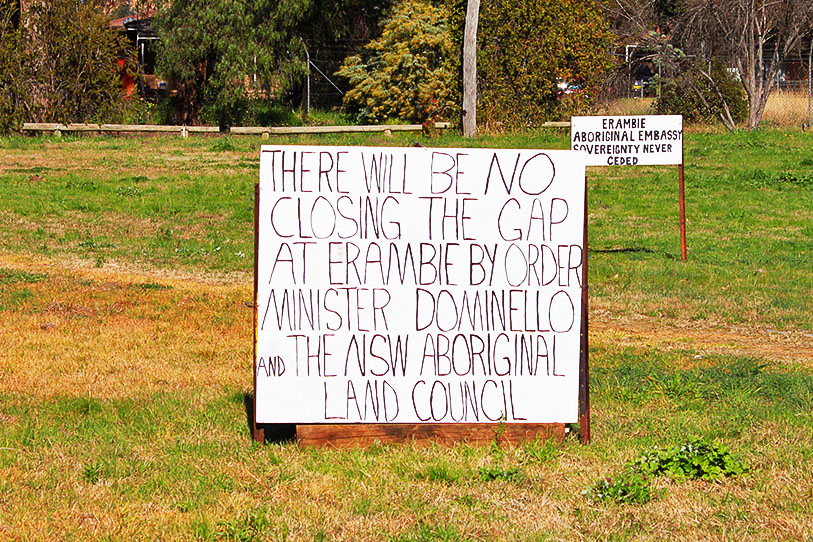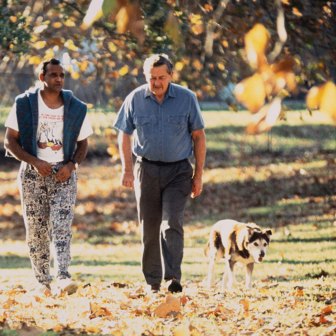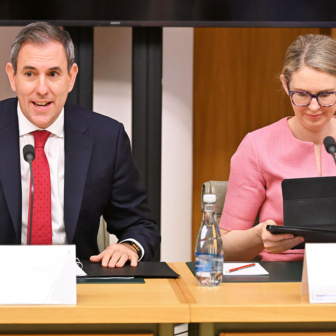As we head towards election day, one policy brings both sides of politics together in furious agreement. Both want to close the Indigenous gap, and both want symbolic recognition of Indigenous people in the constitution in time for the anniversary of the 1967 referendum next year. Yet both sides have steadfastly walked away from the intent of the 1967 referendum, which gave the lead to the federal government in promoting Aboriginal development. Without public debate, the administration of Aboriginal development is now mostly a state government responsibility, particularly in the most important areas of housing and municipal services. This is the Commonwealth’s version of win–win; its bureaucrats and politicians can cut back on funding and wind back on responsibility.
During the manoeuvring to achieve this massive shift in Indigenous policy, Aboriginal people’s deficit, their “gap,” has been front and centre of political discourse. Over the past fifteen years, and increasingly since the Aboriginal and Torres Strait Islander Commission, or ATSIC, was abolished ten years ago, the Commonwealth has used a barrage of deficit metrics as a smokescreen for its retreat.
Deficit metrics dominate Indigenous policy. They describe the variety of ways in which Aboriginal people, as a group, fall short of the rest of the population. They cover almost everything that can be measured in human life, from health and education to safety at home. Like all Indigenous policies since colonial settlement, deficit description was introduced “for the good of the Aborigines,” and like all such policies it has done them little good at all. It measures failure, and in doing so tells white and black alike just how much Aboriginal people are failing. For all its seemingly natural inevitability, it is, in the end, demoralising, demonising, depressing and, as a result, self-fulfilling.
Laurie Bamblett, a Wiradjuri man and the vice-chancellor’s scholar in Indigenous history at the ANU School of History, put it this way in his Reconciliation Week lecture at the Parliamentary Library last year:
I want to protest how people talk about our communities. Especially the slogan “Aboriginal Disadvantage.” I don’t like it. It does more harm than good. I want to get rid of it… If I start by asking you what you know about Aboriginal communities, what image comes to mind? What do you see? I come from a mission called Erambie [near Cowra in New South Wales]. I always describe it as paradise. I’m guessing that’s not the image you have. Am I right?
In public perception, Aboriginal identity is now framed by disease, inadequate education and violence.
It wasn’t always so. There was a time, following the 1967 referendum (which licensed the federal government to build its own Aboriginal affairs bureaucracy), when Aboriginal people were assumed to be brimming with capabilities waiting to be unleashed. This optimism began to peter out in the early 1990s, just in time to collide with the rise of managerialism in the Commonwealth public service. This new style of public service management borrowed the business school mantra “if you can measure it you can manage it,” and deficit metrics began their rule.
The brief twenty- to thirty-year period of Aboriginal optimism came about because the federal government had gained the power to make Aboriginal policy from scratch, taking it over from states still floundering their way out of the era of Native Welfare segregation and protectionism. The 1967 referendum didn’t give Aborigines the vote or grant them citizenship, though it’s true that lifting these restrictions on Aboriginal people at the state level did go hand in hand with the movement to allow the federal government to take the lead in Aboriginal policy.
At Federation the states had agreed that federal parliament had the power “to make laws for the peace, order, and good government of the Commonwealth with respect to… the people of any race, other than the aboriginal people in any State, for whom it is necessary to make special laws.” The referendum removed the prohibition on law-making for Aboriginal people and allowed the Commonwealth to engage directly on its own account. With law-making comes funding, and with funding comes control. There was widespread expectation that the Commonwealth would take the lead, and it stepped up to this challenge remarkably well for twenty-five years.
Before this, Aborigines had been subjects and citizens, but “from time to time,” as former territories minister Paul Hasluck put it in a chapter he contributed to Ronald and Catherine Berndt’s Aboriginal Man in Australia in 1965, “the exercise of their rights of citizenship has been limited by legislation… In this regard their position has been analogous to that of other special classes of citizens who have been limited in their exercise of the normal rights of citizens.” His examples of these are bankrupts, the “mentally afflicted,” habitual drunkards, and people under the age of twenty-one (the voting age at the time).
Amid the international push for decolonisation after the second world war, state governments had gradually lifted restrictions and repealed, amended and renamed their Aboriginal administration legislation. This ensured de facto assimilation, but on its own it was not enough to guarantee material development, particularly in the remote areas. For that to happen, money, vision and national coordination were needed. The Commonwealth government had taken over the major share of revenue-raising during the war (and has hung on to it ever since). It also had the vision, while the state bureaucracies were still mired in a patronising “native welfare” mindset.
The Commonwealth also had the architect of postwar economic reconstruction, H.C. “Nugget” Coombs. Coombs had been one of the “seven dwarves” – the mandarins at the peaks of the Commonwealth public service – and had a passion for Aboriginal people unmatched by any senior bureaucrat since. With his two colleagues in the Council for Aboriginal Affairs, anthropologist W.E.H. Stanner and former diplomat Barry Dexter, he set about bypassing the states and directly funding Aboriginal development through newly minted Aboriginal-controlled community organisations.
Coombs later described Aboriginal incorporated organisations as “a ‘carapace’ within the protection of which Aboriginal groups could experiment with… an acceptable working relationship with white society.” The concept, he wrote, was
seized upon in 1967 by the newly established Council and Office of Aboriginal Affairs and continued to influence the practice of the department when it was established in 1973… It made it possible for such groups to… undertake their own programs, negotiate with governments about these, receive grants-in-aid and establish their own councils, housing and progress associations, business enterprises etc, for the conduct of their own affairs.
By initiating the funding of self-managed community offices, health services, legal services and multi-function homeland support agencies that ultimately led to ATSIC, Coombs had given Aboriginal advocates the organisational infrastructure to be able to complain loudly about their disadvantage and to demand redress.
The success of Coombs’ strategy sowed the seeds of its own downfall. The existence of a vibrant and vocal, yet financially struggling and somewhat flawed, network of Aboriginal organisations provoked Australian conservatives. Liberal leader John Howard was among those who reacted negatively, first because these groups were a philosophical challenge to his deeply held conviction that “the common values” of the English-speaking countries should rule in Australia. As he declared in a different context in 2011, “I am a passionate believer in multiracialism… But when a nation draws people from other parts of the world, it draws them because of the magnetism of its own culture and its own way of life, and the ideal [is] to unite them behind the common values of the country which has made them welcome.” The rise of a sector espousing distinct cultural values within his own jurisdiction was philosophically unacceptable.
He was also politically challenged, seeing Aboriginal advocates as aligned with his political opponents. There was, no doubt, a fiscal consideration too. The rise of the Aboriginal sector placed a burden on the budget and, to rub salt in this wound, the persistence of Aboriginal poverty became a Commonwealth political liability.
Howard’s war on ATSIC began as soon as he took office. His first press conference as prime minister was held with his Aboriginal affairs minister, John Herron, standing behind him as he announced an audit of all of the community organisations funded by ATSIC, clearly signalling a belief that they were corrupt and incompetent and that ATSIC was complicit.
Unsubstantiated smears of this kind characterised the Howard years, reaching new lows with the military-style intervention in the Northern Territory under the flag of protection of children from violent, alcohol-ridden sexual abusers. Not surprisingly, the intervention was a turning point in public support for Aboriginal development. This hammering away at the multitude of ways in which Aboriginal people had failed brought widespread disenchantment not with Aboriginal policy, but with Aboriginal people themselves. They had failed to meet the requirements of the majority, and even sympathetic urban whites didn’t know what to think any more.
Deficit metrics played a big part. They had been introduced as one arm of a multipronged attack on Aboriginal disadvantage at the first meeting of the newly minted Council of Australian Governments, or COAG, in Perth in December 1992. The National Commitment to Improved Outcomes in the Delivery of Services to Aboriginal and Torres Strait Islander Peoples, adopted at that meeting, threw out the post-1967 arrangement, under which the Commonwealth had effectively taken over state government Aboriginal affairs agencies, and substituted bilateral agreements tied to performance. At that point, though, the states still insisted that “sustained levels of Commonwealth funding will be based on the principle of the Commonwealth continuing to have a special responsibility in Aboriginal Affairs, including where appropriate, the provision of funds and resources under agreements.”
Performance must be measured against a baseline, of course, and so deficit metrics were incorporated in the sidelines of the agreement. Rather innocuously, the governments agreed on “procedures for monitoring objectives and outcomes” and “provision for nationally consistent statistical reports with a policy orientation.” The final item in the agreement was that
the governments of Australia agree that the Australian Aboriginal Affairs Council review annually progress in the achievement of improved outcomes in the delivery of programs and services for Aboriginal peoples and Torres Strait Islanders; and affirm their commitment to accountability in provision of programs and services for [them].
If you can measure it, you can manage it.
The Commonwealth had another more pressing purpose in brokering the agreement. This was to re-engage state governments, who for more than two decades had been happy for the Commonwealth to pay the bills and wear the blame for failures.
The agreement fired the first shots in the turf war between the states and the Commonwealth, with the Commonwealth trying to get the states to recommit to funding services and the states insisting on the continued role of the Commonwealth. It was here that the concept of shared responsibility was first introduced, though at first it applied to the states and was only later appropriated by the Howard government to badger Aboriginal people into being more responsible citizens under Shared Responsibility Agreements, or SRAs.
By this time, after ATSIC’s abolition, deficit metrics were firmly entrenched. SRAs forced on Aboriginal communities by the Howard government listed in precise particulars the areas of deficit that a community must improve in order to qualify for development grants.
This relentless talking down of a people already well down was essential to the strategy of disengaging the Commonwealth government and reversing the intent of the 1967 referendum. After all, what can you do with people who receive so much help but steadfastly refuse to improve themselves?
COAG’s embrace of the Close the Gap campaign melded well with this tactic. Originally a community demand to Close the Gap in health, the brand was taken over by COAG, which, with a slight tweak of the label to Closing the Gap, married it to its existing arrangement with the Productivity Commission to measure continuing Aboriginal disadvantage. This measurement was instituted in 2002, fifteen years ago, and has still not resulted in improvements.
Closing the Gap’s targets in seven key areas, the annual statement to parliament on the Indigenous deficit, the biennial Productivity Commission report on failures in redressing disadvantage – all were foreshadowed in the 1992 COAG agreement that had signalled the end of optimism, the end of self-determination, the end of Commonwealth leadership and the onset of disillusion. Worst of all, perhaps, is the collateral damage caused by this process. The discourse of Aboriginal failure is most likely one of the major contributing factors to their disadvantage.
By replacing bilateral agreements with National Partnership Agreements under the new Federal Financial Relations Act in 2008, the Commonwealth divested itself, quietly and without public debate, of responsibility for Aboriginal development. Its two pillars, housing and municipal and essential services, are now the responsibility of state governments.
It was a masterful policy of the Howard years, embraced also by Kevin Rudd, Julia Gillard and Jenny Macklin, to wash the Commonwealth’s hands of the poorest of the poor. That is not how Aboriginal people see themselves and their communities, but they know it is the way that they are perceived.
Laurie Bamblett again:
If we talk more about Aboriginal Advantage, we’ll be moving away from something that doesn’t work. Telling people they’re disadvantaged kills them. It takes their power and authority away. It disengages them. It makes it okay for them to say no. It frees people of obligation. The opposite of what we want. I really think those words “Aboriginal Disadvantage” are that bad. Think about it. How would you like to hear that all the time? Not only that, how do you think it feels that it sometimes doesn’t even need to be said any more? It’s just accepted…
He also talked about trail-blazing musicians and athletes who had grown up in Erambie and said:
Compare Don Bradman using a stump, a golf ball and water tank to become a champion. That story is seen as an example of Australian ingenuity and cheek. Evonne Goolagong doing basically the same thing to become a champion tennis player is seen as a poor bugger me story. It proves our disadvantage.
Think about this. There’s never been more than twenty-eight houses at Erambie. No more than 200 people living there at any time. Yet on top of the success I’ve just talked about, we have PhDs, masters degrees, a barrister, lawyers, a Harvard graduate and university-trained teachers.
Deficit is not an individual characteristic. Deficit metrics act like mud flung at an entire group on account of their inherent, inescapable identity. The danger, as always, is that resilience and resistance is manifested not by contest and denial – the forces stacked against Aboriginal people make that a thankless strategy – but by defiantly flinging the negativity back in the faces of those who piously recount it.
And so we arrive at a stalemate that suits all governments well. Good white people throw up their hands and wonder what, after all, can be done about “the Aboriginal problem.” We have tried so much, received so little thanks, and in the end they won’t help themselves. The Commonwealth has backed out; the states will assimilate their Aboriginal populations into their underclass; top-up handouts are flung around as an Indigenous Advancement Strategy; and, like mainstream politics, no side is bold enough to put forward a vision. Farewell 1967. •




